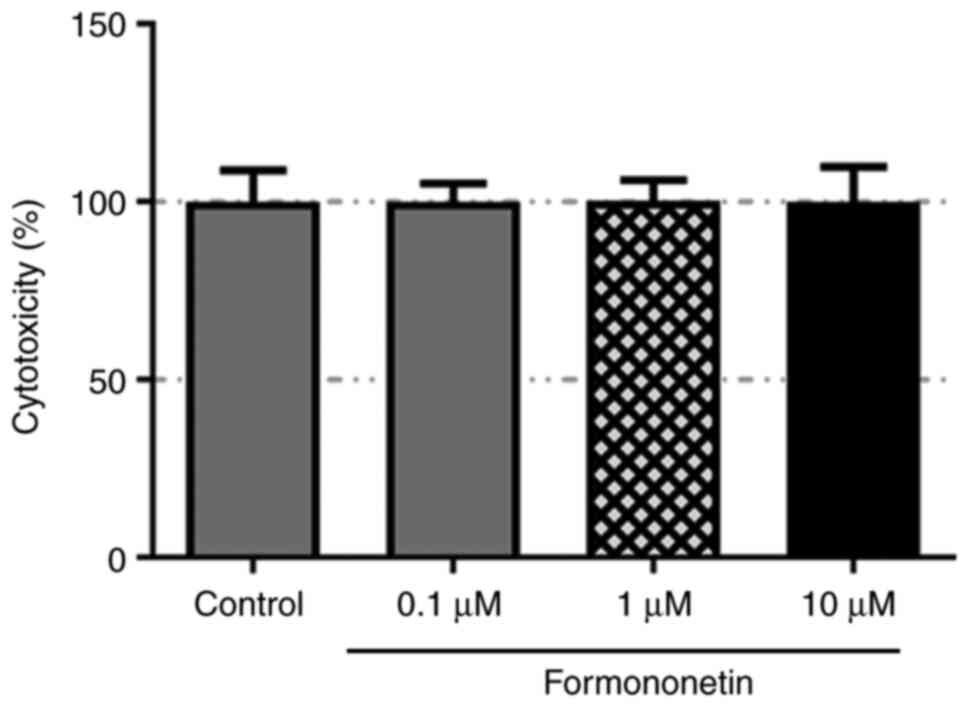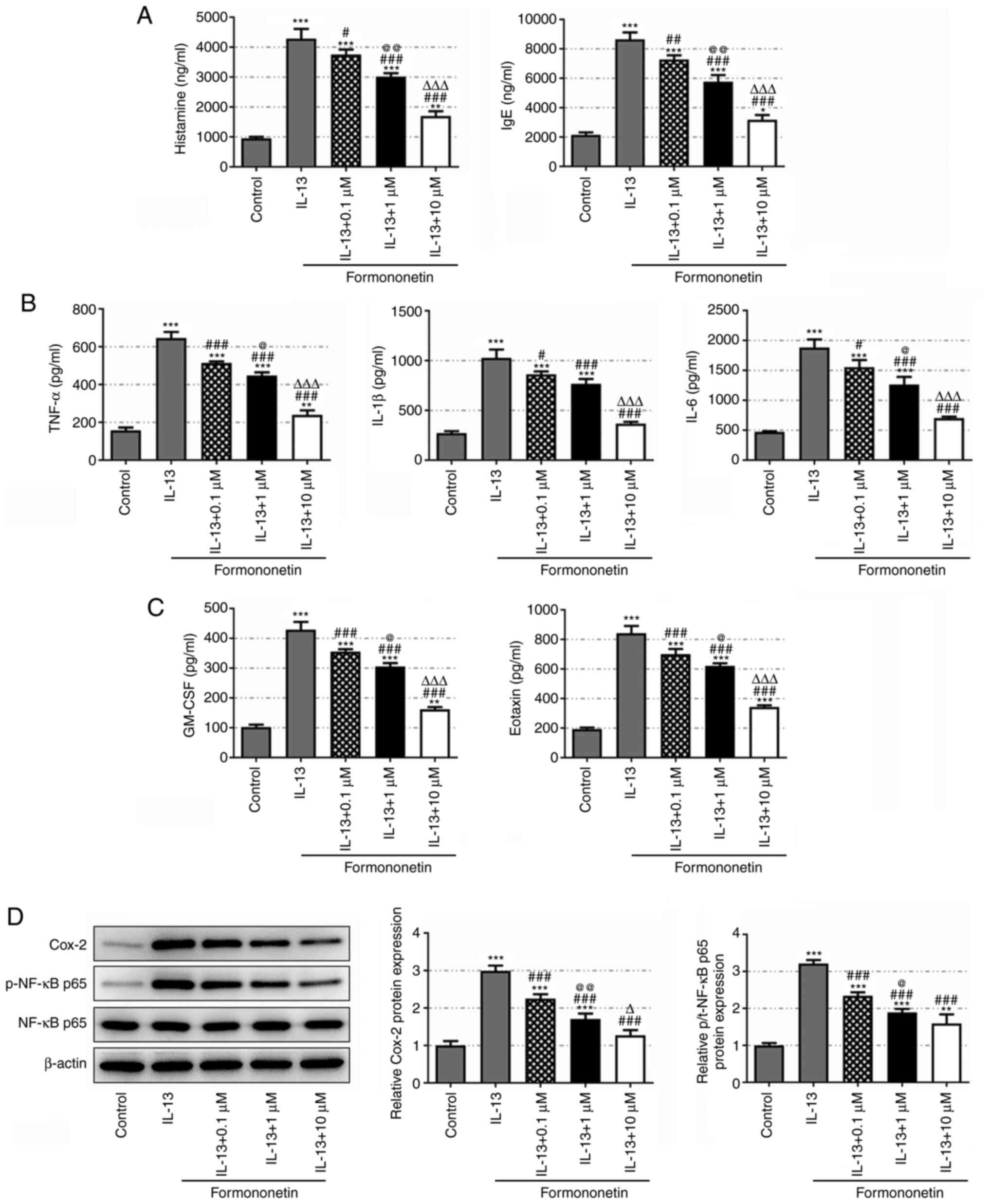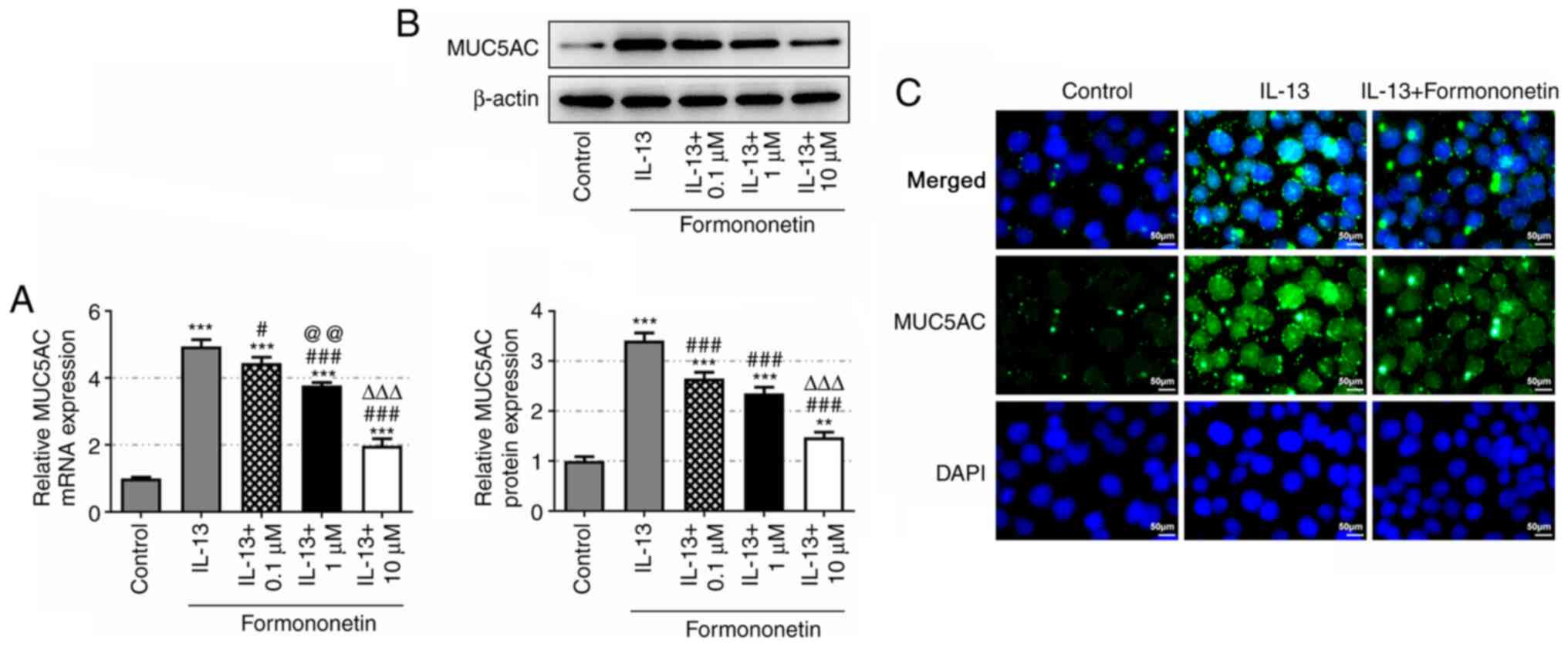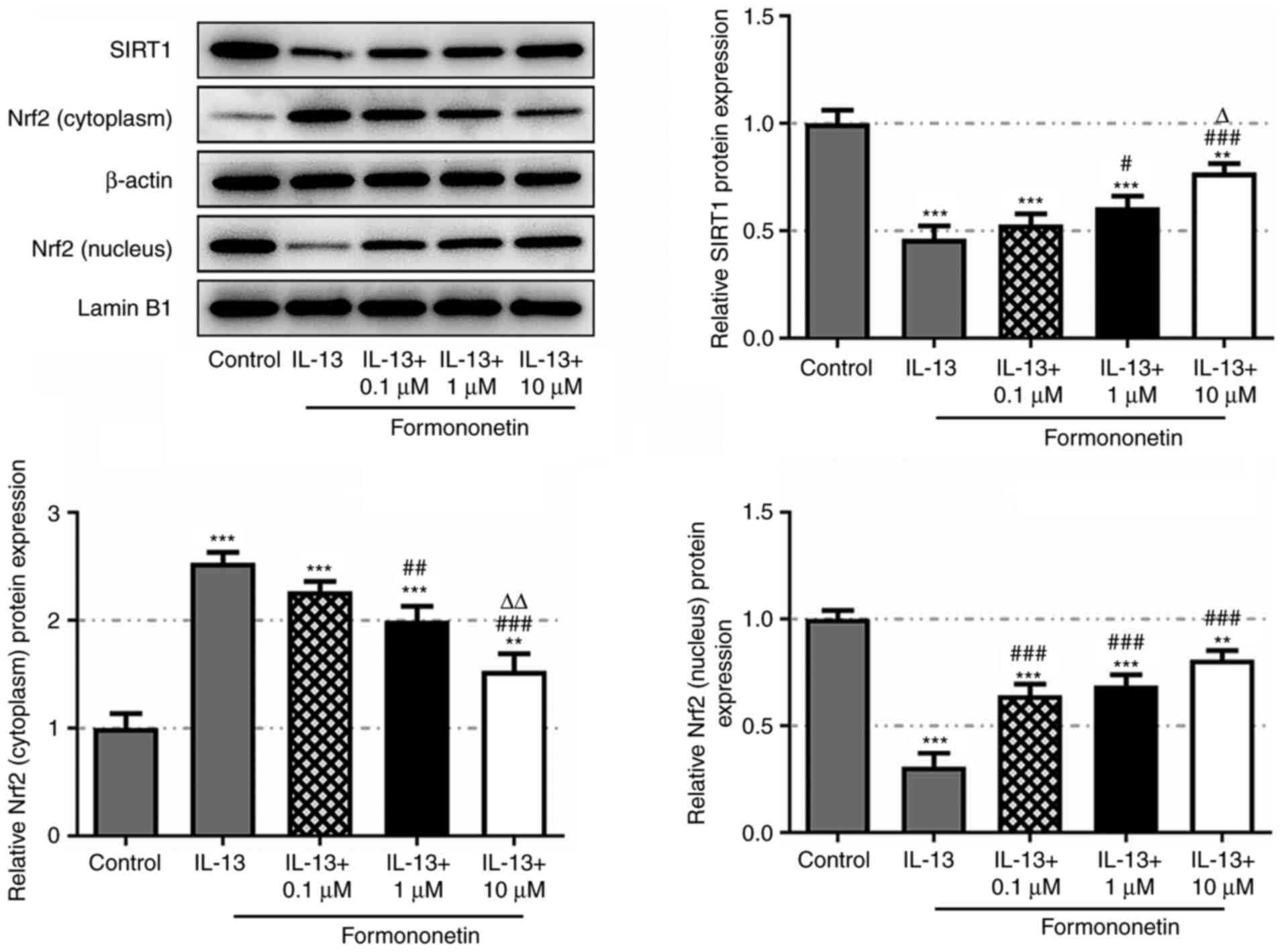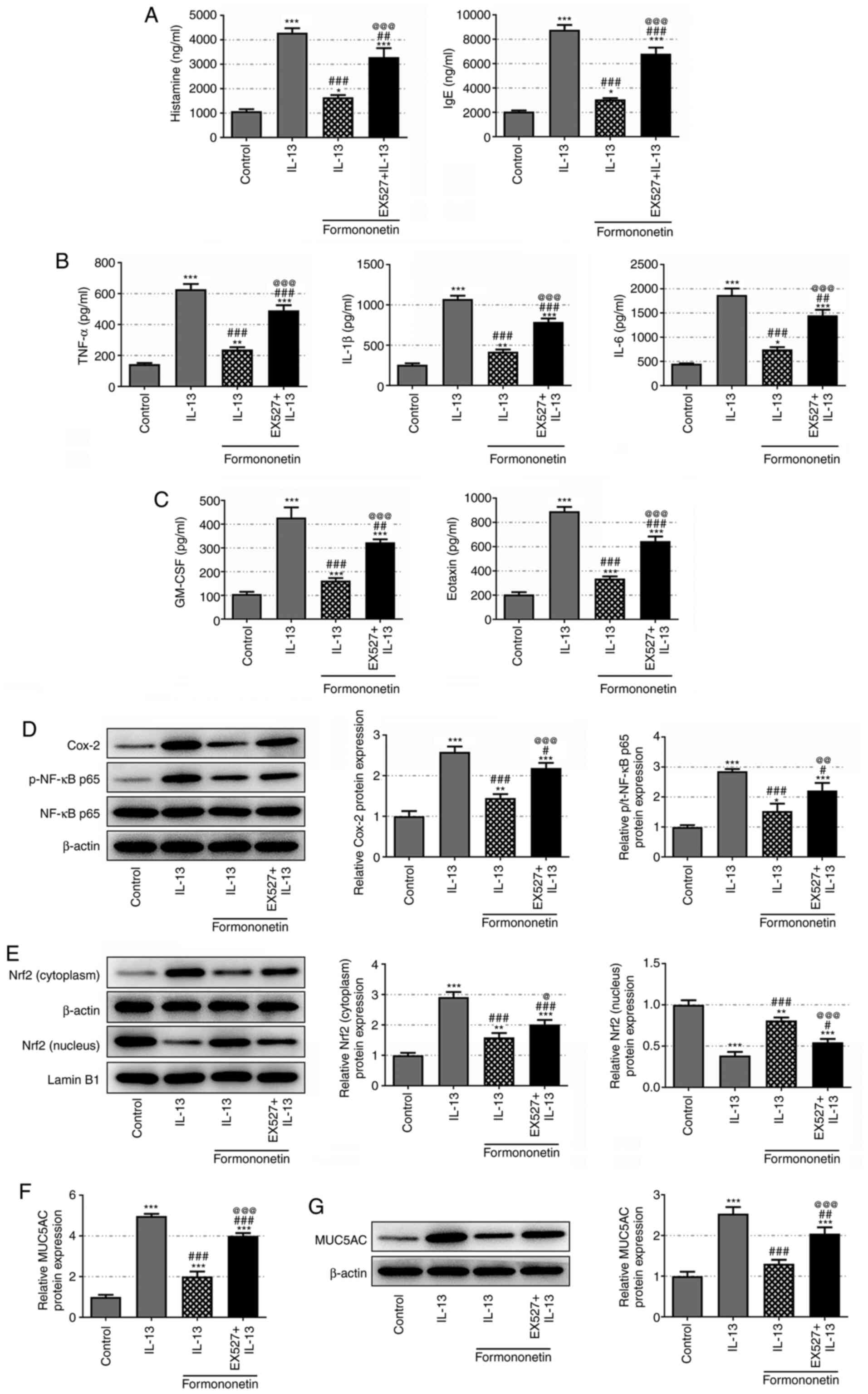|
1
|
Hoyte FCL and Nelson HS: Recent advances
in allergic rhinitis. F1000Res. 7:F1000Faculty Rev-1333. 2018.
View Article : Google Scholar : PubMed/NCBI
|
|
2
|
Dávila I, Mullol J, Ferrer M, Bartra J,
del Cuvillo A, Montoro J, Jáuregui I, Sastre J and Valero A:
Genetic aspects of allergic rhinitis. J Investig Allergol Clin
Immunol. 19 (Suppl 1):S25–S31. 2009.PubMed/NCBI
|
|
3
|
Incorvaia C, Cavaliere C, Frati F and
Masieri S: Allergic rhinitis. J Biol Regul Homeost Agents. 32
(Suppl 1):S61–S66. 2018.PubMed/NCBI
|
|
4
|
Numminen J: Allergic rhinitis. Duodecim.
133:473–478. 2017.PubMed/NCBI
|
|
5
|
Brożek JL, Bousquet J, Agache I, Agarwal
A, Bachert C, Bosnic-Anticevich S, Brignardello-Petersen R,
Canonica GW, Casale T, Chavannes NH, et al: Allergic rhinitis and
its impact on asthma (ARIA) guidelines-2016 revision. J Allergy
Clin Immunol. 140:950–958. 2017. View Article : Google Scholar : PubMed/NCBI
|
|
6
|
Bao H, Si D, Gao L, Sun H, Shi Q, Yan Y,
Damchaaperenlei D, Li C, Yu M and Li Y: Acupuncture for the
treatment of allergic rhinitis: A systematic review protocol.
Medicine (Baltimore). 97:e137722018. View Article : Google Scholar : PubMed/NCBI
|
|
7
|
Meltzer EO: Allergic rhinitis: Burden of
illness, quality of life, comorbidities, and control. Immunol
Allergy Clin North Am. 36:235–248. 2016. View Article : Google Scholar : PubMed/NCBI
|
|
8
|
Gampe N, Darcsi A, Lohner S, Béni S and
Kursinszki L: Characterization and identification of isoflavonoid
glycosides in the root of Spiny restharrow (Ononis spinosa L.) by
HPLC-QTOF-MS, HPLC-MS/MS and NMR. J Pharm Biomed Anal. 123:74–81.
2016. View Article : Google Scholar : PubMed/NCBI
|
|
9
|
Ong SKL, Shanmugam MK, Fan L, Fraser SE,
Arfuso F, Ahn KS, Sethi G and Bishayee A: Focus on formononetin:
Anticancer potential and molecular targets. Cancers (Basel).
11:6112019. View Article : Google Scholar : PubMed/NCBI
|
|
10
|
Yao JN, Zhang XX, Zhang YZ, Li JH, Zhao
DY, Gao B, Zhou HN, Gao SL and Zhang LF: Discovery and anticancer
evaluation of a formononetin derivative against gastric cancer
SGC7901 cells. Invest New Drugs. 37:1300–1308. 2019. View Article : Google Scholar : PubMed/NCBI
|
|
11
|
Zhang J, Liu L, Wang J, Ren B, Zhang L and
Li W: Formononetin, an isoflavone from Astragalus membranaceus
inhibits proliferation and metastasis of ovarian cancer cells. J
Ethnopharmacol. 221:91–99. 2018. View Article : Google Scholar : PubMed/NCBI
|
|
12
|
Zhang L, Gong Y, Wang S and Gao F:
Anti-colorectal cancer mechanisms of formononetin identified by
network pharmacological approach. Med Sci Monit. 25:7709–7714.
2019. View Article : Google Scholar : PubMed/NCBI
|
|
13
|
Yi L, Cui J, Wang W, Tang W, Teng F, Zhu
X, Qin J, Wuniqiemu T, Sun J, Wei Y and Dong J: Formononetin
attenuates airway inflammation and oxidative stress in murine
allergic asthma. Front Pharmacol. 11:5338412020. View Article : Google Scholar : PubMed/NCBI
|
|
14
|
Yuan W, Chen Y, Zhou Y, Bao K, Yu X, Xu Y,
Zhang Y, Zheng J, Jiang G and Hong M: Formononetin attenuates
atopic dermatitis by upregulating A20 expression via activation of
G protein-coupled estrogen receptor. J Ethnopharmacol.
266:1133972021. View Article : Google Scholar : PubMed/NCBI
|
|
15
|
Yuan Y, Liu Q, Zhao J, Tang H and Sun J:
SIRT1 attenuates murine allergic rhinitis by downregulated HMGB
1/TLR4 pathway. Scand J Immunol. 87:e126672018. View Article : Google Scholar : PubMed/NCBI
|
|
16
|
Piao CH, Fan YJ, Nguyen TV, Song CH and
Chai OH: Mangiferin alleviates ovalbumin-induced allergic rhinitis
via Nrf2/HO-1/NF-κB signaling pathways. Int J Mol Sci. 21:34152020.
View Article : Google Scholar : PubMed/NCBI
|
|
17
|
Yang S, Wei L, Xia R, Liu L, Chen Y, Zhang
W, Li Q, Feng K, Yu M, Zhang W, et al: Formononetin ameliorates
cholestasis by regulating hepatic SIRT1 and PPARα. Biochem Biophys
Res Commun. 512:770–778. 2019. View Article : Google Scholar : PubMed/NCBI
|
|
18
|
Wills-Karp M: Interleukin-13 in asthma
pathogenesis. Immunol Rev. 202:175–190. 2004. View Article : Google Scholar : PubMed/NCBI
|
|
19
|
Matsukura S, Stellato C, Georas SN,
Casolaro V, Plitt JR, Miura K, Kurosawa S, Schindler U and
Schleimer RP: Interleukin-13 upregulates eotaxin expression in
airway epithelial cells by a STAT6-dependent mechanism. Am J Respir
Cell Mol Biol. 24:755–761. 2001. View Article : Google Scholar : PubMed/NCBI
|
|
20
|
Wang B, Gao Y, Zheng G, Ren X, Sun B, Zhu
K, Luo H, Wang Z and Xu M: Platycodin D inhibits
interleukin-13-induced the expression of inflammatory cytokines and
mucus in nasal epithelial cells. Biomed Pharmacother. 84:1108–1112.
2016. View Article : Google Scholar : PubMed/NCBI
|
|
21
|
Xu N and An J: Formononetin ameliorates
mast cell-mediated allergic inflammation via inhibition of
histamine release and production of pro-inflammatory cytokines. Exp
Ther Med. 14:6201–6206. 2017.PubMed/NCBI
|
|
22
|
Wang Y, Che J, Zhao H, Tang J and Shi G:
Paeoniflorin attenuates oxidized low-density lipoprotein-induced
apoptosis and adhesion molecule expression by autophagy enhancement
in human umbilical vein endothelial cells. J Cell Biochem.
120:9291–9299. 2019. View Article : Google Scholar : PubMed/NCBI
|
|
23
|
Jia M, Chen X, Liu J and Chen J: PTEN
promotes apoptosis of H2O2-injured rat nasal epithelial cells
through PI3K/Akt and other pathways. Mol Med Rep. 17:571–579.
2018.PubMed/NCBI
|
|
24
|
Sun B, Wang B and Xu M: Esculetin inhibits
histamine-induced expression of inflammatory cytokines and mucin in
nasal epithelial cells. Clin Exp Pharmacol Physiol. 46:821–827.
2019. View Article : Google Scholar : PubMed/NCBI
|
|
25
|
Livak KJ and Schmittgen TD: Analysis of
relative gene expression data using real-time quantitative PCR and
the 2(-Delta Delta C(T)) method. Methods. 25:402–408. 2001.
View Article : Google Scholar : PubMed/NCBI
|
|
26
|
Kwak S, Choi YS, Na HG, Bae CH, Song SY
and Kim YD: Fipronil upregulates inflammatory cytokines and MUC5AC
expression in human nasal epithelial cells. Rhinology. 58:66–73.
2020.PubMed/NCBI
|
|
27
|
Shah SA, Ishinaga H, Hou B, Okano M and
Takeuchi K: Effects of interleukin-31 on MUC5AC gene expression in
nasal allergic inflammation. Pharmacology. 91:158–164. 2013.
View Article : Google Scholar : PubMed/NCBI
|
|
28
|
Wang X, Li Y, Luo D, Wang X, Zhang Y, Liu
Z, Zhong N, Wu M and Li G: Lyn regulates mucus secretion and MUC5AC
via the STAT6 signaling pathway during allergic airway
inflammation. Sci Rep. 7:426752017. View Article : Google Scholar : PubMed/NCBI
|
|
29
|
Cheng L, Chen J, Fu Q, He S, Li H, Liu Z,
Tan G, Tao Z, Wang D, Wen W, et al: Chinese society of allergy
guidelines for diagnosis and treatment of allergic rhinitis.
Allergy Asthma Immunol Res. 10:300–353. 2018. View Article : Google Scholar : PubMed/NCBI
|
|
30
|
Kakli HA and Riley TD: Allergic rhinitis.
Prim Care. 43:465–475. 2016. View Article : Google Scholar : PubMed/NCBI
|
|
31
|
Meng Y, Wang C and Zhang L: Recent
developments and highlights in allergic rhinitis. Allergy.
74:2320–2328. 2019. View Article : Google Scholar : PubMed/NCBI
|
|
32
|
Schuler Iv CF and Montejo JM: Allergic
rhinitis in children and adolescents. Pediatr Clin North Am.
66:981–993. 2019. View Article : Google Scholar : PubMed/NCBI
|
|
33
|
Noguchi E, Shibasaki M, Arinami T, Takeda
K, Maki T, Miyamoto T, Kawashima T, Kobayashi K and Hamaguchi H:
Evidence for linkage between asthma/atopy in childhood and
chromosome 5q31-q33 in a Japanese population. Am J Respir Crit Care
Med. 156:1390–1393. 1997. View Article : Google Scholar : PubMed/NCBI
|
|
34
|
Andiappan AK, Wang de Y, Anantharaman R,
Suri BK, Lee BT, Rotzschke O, Liu J and Chew FT: Replication of
genome-wide association study loci for allergic rhinitis and house
dust mite sensitization in an Asian population of ethnic Chinese in
Singapore. J Allergy Clin Immunol. 131:1431–1433.e8. 2013.
View Article : Google Scholar : PubMed/NCBI
|
|
35
|
Teng B, Zhang X, Yi C, Zhang Y, Ye S, Wang
Y, Tong DQ and Lu B: The association between ambient air pollution
and allergic rhinitis: Further epidemiological evidence from
Changchun, Northeastern China. Int J Environ Res Public Health.
14:2262017. View Article : Google Scholar : PubMed/NCBI
|
|
36
|
Li CW, Chen DH DH, Zhong JT, Lin ZB, Peng
H, Lu HG, Yang Y, Yin J and Li TY: Epidemiological characterization
and risk factors of allergic rhinitis in the general population in
Guangzhou City in China. PLoS One. 9:e1149502014. View Article : Google Scholar : PubMed/NCBI
|
|
37
|
Akhouri S, House SA and Doerr C: Allergic
rhinitis (nursing). StatPearls; Treasure Island (FL): 2021
|
|
38
|
Bernstein DI, Schwartz G and Bernstein JA:
Allergic rhinitis: Mechanisms and treatment. Immunol Allergy Clin
North Am. 36:261–278. 2016. View Article : Google Scholar : PubMed/NCBI
|
|
39
|
Wang XS, Guan SY, Liu A, Yue J, Hu LN,
Zhang K, Yang LK, Lu L, Tian Z, Zhao MG and Liu SB: Anxiolytic
effects of formononetin in an inflammatory pain mouse model. Mol
Brain. 12:362019. View Article : Google Scholar : PubMed/NCBI
|
|
40
|
Tay KC, Tan LT, Chan CK, Hong SL, Chan KG,
Yap WH, Pusparajah P, Lee LH and Goh BH: Formononetin: A review of
its anticancer potentials and mechanisms. Front Pharmacol.
10:8202019. View Article : Google Scholar : PubMed/NCBI
|
|
41
|
Li L, Wang Y, Wang X, Tao Y, Bao K, Hua Y,
Jiang G and Hong M: Formononetin attenuated allergic diseases
through inhibition of epithelial-derived cytokines by regulating
E-cadherin. Clin Immunol. 195:67–76. 2018. View Article : Google Scholar : PubMed/NCBI
|
|
42
|
Yi L, Lu Y, Yu S, Cheng Q and Yi L:
Formononetin inhibits inflammation and promotes gastric mucosal
angiogenesis in gastric ulcer rats through regulating NF-κB
signaling pathway. J Recept Signal Transduct Res. Oct 26–2020.(Epub
ahead of print). View Article : Google Scholar : PubMed/NCBI
|
|
43
|
Taylor-Clark T: Histamine in allergic
rhinitis. Adv Exp Med Biol. 709:33–41. 2010. View Article : Google Scholar : PubMed/NCBI
|
|
44
|
Hanzlikova J, Sedlacek D, Liska M,
Gorcikova J, Vlas T, Amiramini S, Panzner P and Maly M: Histamine
increases the level of IFNγ produced by HIV-1 specific CTLs and
this production depends on total IgE level. J Immunol Methods.
375:1–6. 2012. View Article : Google Scholar : PubMed/NCBI
|
|
45
|
Gould HJ and Sutton BJ: IgE in allergy and
asthma today. Nat Rev Immunol. 8:205–217. 2008. View Article : Google Scholar : PubMed/NCBI
|
|
46
|
Barni S, Liccioli G, Sarti L, Giovannini
M, Novembre E and Mori F: Immunoglobulin E (IgE)-mediated food
allergy in children: Epidemiology, pathogenesis, diagnosis,
prevention, and management. Medicina (Kaunas). 56:1112020.
View Article : Google Scholar : PubMed/NCBI
|
|
47
|
Bayar Muluk N, Bafaqeeh SA and Cingi C:
Anti-IgE treatment in allergic rhinitis. Int J Pediatr
Otorhinolaryngol. 127:1096742019. View Article : Google Scholar : PubMed/NCBI
|
|
48
|
Fireman P: Cytokines and allergic
rhinitis. Allergy Asthma Proc. 17:175–178. 1996. View Article : Google Scholar : PubMed/NCBI
|
|
49
|
Ohkubo K, Ikeda M, Pawankar R, Gotoh M,
Yagi T and Okuda M: Mechanisms of IL-6, IL-8, and GM-CSF release in
nasal secretions of allergic patients after nasal challenge.
Rhinology. 36:156–161. 1998.PubMed/NCBI
|
|
50
|
Peric A, Spadijer-Mirkovic C,
Matkovic-Jozin S, Jovancevic L and Vojvodic D:
Granulocyte-macrophage colony-stimulating factor production and
tissue eosinophilia in chronic rhinitis. Int Arch Otorhinolaryngol.
20:364–369. 2016. View Article : Google Scholar : PubMed/NCBI
|
|
51
|
López DE and Ballaz SJ: The role of brain
cyclooxygenase-2 (Cox-2) beyond neuroinflammation: Neuronal
homeostasis in memory and anxiety. Mol Neurobiol. 57:5167–5176.
2020. View Article : Google Scholar : PubMed/NCBI
|
|
52
|
Cui J and Jia J: Natural COX-2 inhibitors
as promising anti-inflammatory agents: An update. Curr Med Chem.
28:3622–3646. 2021. View Article : Google Scholar : PubMed/NCBI
|
|
53
|
Li Z, Dong X, Zhang J, Zeng G, Zhao H, Liu
Y, Qiu R, Mo L and Ye Y: Formononetin protects TBI rats against
neurological lesions and the underlying mechanism. J Neurol Sci.
338:112–117. 2014. View Article : Google Scholar : PubMed/NCBI
|
|
54
|
Aladaileh SH, Hussein OE, Abukhalil MH,
Saghir SAM, Bin-Jumah M, Alfwuaires MA, Germoush MO, Almaiman AA
and Mahmoud AM: Formononetin upregulates Nrf2/HO-1 signaling and
prevents oxidative stress, inflammation, and kidney injury in
methotrexate-induced rats. Antioxidants (Basel). 8:4302019.
View Article : Google Scholar : PubMed/NCBI
|
|
55
|
Pradère JP, Hernandez C, Koppe C, Friedman
RA, Luedde T and Schwabe RF: Negative regulation of NF-κB p65
activity by serine 536 phosphorylation. Sci Signal. 9:ra852016.
View Article : Google Scholar : PubMed/NCBI
|
|
56
|
Huh JE, Lee WI, Kang JW, Nam D, Choi DY,
Park DS, Lee SH and Lee JD: Formononetin attenuates
osteoclastogenesis via suppressing the RANKL-induced activation of
NF-κB, c-Fos, and nuclear factor of activated T-cells cytoplasmic 1
signaling pathway. J Nat Prod. 77:2423–2431. 2014. View Article : Google Scholar : PubMed/NCBI
|
|
57
|
Liao L, Huang L, Wei X, Yin L, Wei X and
Li T: Bioinformatic and biochemical studies of formononetin against
liver injure. Life Sci. 272:1192292021. View Article : Google Scholar : PubMed/NCBI
|
|
58
|
Okuda K, Chen G, Subramani DB, Wolf M,
Gilmore RC, Kato T, Radicioni G, Kesimer M, Chua M, Dang H, et al:
Localization of secretory mucins MUC5AC and MUC5B in normal/healthy
human airways. Am J Respir Crit Care Med. 199:715–727. 2019.
View Article : Google Scholar : PubMed/NCBI
|
|
59
|
Zhang YZ, Wu QJ, Yang X, Xing XX, Chen YY
and Wang H: Effects of SIRT1/Akt pathway on chronic inflammatory
response and lung function in patients with asthma. Eur Rev Med
Pharmacol Sci. 23:4948–4953. 2019.PubMed/NCBI
|
|
60
|
Wu Z, Chen J, Zhao W, Zhuo CH and Chen Q:
Inhibition of miR-181a attenuates sepsis-induced inflammation and
apoptosis by activating Nrf2 and inhibiting NF-κB pathways via
targeting SIRT1. Kaohsiung J Med Sci. 37:200–207. 2021. View Article : Google Scholar : PubMed/NCBI
|
|
61
|
Oza MJ and Kulkarni YA: Formononetin
ameliorates diabetic neuropathy by increasing expression of SIRT1
and NGF. Chem Biodivers. 17:e20001622020. View Article : Google Scholar : PubMed/NCBI
|
|
62
|
Hwang JS, Kang ES, Han SG, Lim DS, Paek
KS, Lee CH and Seo HG: Formononetin inhibits
lipopolysaccharide-induced release of high mobility group box 1 by
upregulating SIRT1 in a PPARδ-dependent manner. PeerJ. 6:e42082018.
View Article : Google Scholar : PubMed/NCBI
|
|
63
|
Li J, Wang B, Luo Y, Zhang Q, Bian Y and
Wang R: Resveratrol-mediated SIRT1 activation attenuates
ovalbumin-induced allergic rhinitis in mice. Mol Immunol.
122:156–162. 2020. View Article : Google Scholar : PubMed/NCBI
|
|
64
|
Niu Y, Wang J, Li Z, Yao K, Wang L and
Song J: HIF1α deficiency in dendritic cells attenuates symptoms and
inflammatory indicators of allergic rhinitis in a SIRT1-dependent
manner. Int Arch Allergy Immunol. 181:585–593. 2020. View Article : Google Scholar : PubMed/NCBI
|
|
65
|
Van Nguyen T, Piao CH, Fan YJ, Shin DU,
Kim SY, Song HJ, Song CH, Shin HS and Chai OH: Anti-allergic
rhinitis activity of α-lipoic acid via balancing Th17/Treg
expression and enhancing Nrf2/HO-1 pathway signaling. Sci Rep.
10:125282020. View Article : Google Scholar : PubMed/NCBI
|
|
66
|
Jung KA and Kwak MK: The Nrf2 system as a
potential target for the development of indirect antioxidants.
Molecules. 15:7266–7291. 2010. View Article : Google Scholar : PubMed/NCBI
|















